Diversity, equity, and inclusion (DE&I) have become critical elements of a thriving workplace. The importance of DE&I cannot be overstated, as it benefits not only individuals but also organizations as a whole. Therefore, companies that prioritize DE&I in their policies, practices, and workplace culture stand to reap significant rewards. In this article, we explore the critical importance of DE&I in the workplace and why organizations need to prioritize it.
Workplace Culture
First and foremost, DE&I is crucial in creating a workplace environment where everyone feels valued and respected, regardless of their background, gender, race, or religion. When an organization prioritizes DE&I, it sends a clear message to its employees that their backgrounds, identities, and perspectives are important and valued. This, in turn, leads to a workplace culture that celebrates diversity and fosters a sense of belonging among all employees. Furthermore, when employees feel valued and respected, they are more likely to be engaged and motivated, leading to higher levels of productivity, collaboration, and innovation, as diverse perspectives and experiences bring new insights and approaches to problem-solving.
Attracting and Retaining Top Talent
In addition to fostering a positive workplace culture, DE&I plays a vital role in attracting and retaining top talent. Job seekers today are looking for more than just a paycheck; they want to work for a company that shares their values and promotes an inclusive culture. As a result, organizations prioritizing DE&I are seen as more attractive to candidates, particularly those from underrepresented backgrounds. Furthermore, a diverse and inclusive workplace can increase employee satisfaction and retention rates. Finally, a diverse workforce can help companies better understand and serve a diverse customer and client base, increasing business opportunities and growth. When employees feel like they belong and are valued for who they are, they are more likely to stay with the organization long-term.
The Effects of Not Prioritizing DE&I
On the other hand, the adverse effects of not prioritizing DE&I in the workplace can be far-reaching and detrimental to both individuals and the organization as a whole. For example, a lack of diversity and inclusion can lead to groupthink, where individuals are less likely to challenge the status quo or offer new ideas, resulting in a stagnant workplace culture. This, in turn, can lead to decreased productivity, employee disengagement, and difficulty attracting and retaining top talent. Moreover, a lack of DE&I can lead to discrimination, harassment, and bias, creating a toxic work environment that harms employee well-being and negatively impacts the organization’s reputation. Ultimately, organizations that do not prioritize DE&I risk missing out on the benefits of a diverse and inclusive workforce.
Ways to Prioritize DE&I
To prioritize DE&I in the workplace, organizations should actively seek out diverse candidates for open positions, provide training and education on unconscious bias and cultural competence, and create an inclusive workplace culture that values diversity and encourages open communication. This means providing employees with opportunities to share their perspectives and ideas, offering training and development programs to promote diversity and inclusion, and regularly assessing the organization’s policies and practices to ensure they promote fairness and equity. Some ways include:
- Leadership commitment: Setting the tone from the top down is essential. Leaders must demonstrate their commitment by investing time, resources, and budget into DE&I initiatives and setting clear goals for DE&I outcomes.
- Diversity in recruitment: Organizations should ensure that their recruitment process is inclusive and attracts a diverse pool of candidates. This can involve reviewing and updating job descriptions to avoid any biased language and expanding outreach to underrepresented groups.
- Employee training: Providing regular training sessions on DE&I can help employees understand the importance in the workplace and how to create a more inclusive environment.
- Equity-focused policies: Organizations should review their policies and procedures to ensure they are equitable and provide equal opportunities for all employees. This includes reviewing pay structures, performance evaluation criteria, and promotion processes.
- Listening and engagement: Organizations should actively listen to feedback from employees, especially from underrepresented groups, to identify areas for improvement and take action to address any issues. This can involve creating open channels for feedback, such as anonymous surveys or town hall meetings.
- Partnering with diversity-focused organizations: Organizations can also partner with external organizations focused on DE&I to learn best practices and develop strategies for creating a more inclusive workplace.
Conclusion
DE&I is vital for a thriving workplace and a successful organization. It fosters creativity, innovation, and productivity, attracts top talent, and better serves diverse customer and client bases. Organizations must prioritize DE&I in all operations to create a workplace environment that values and respects all individuals, regardless of their background or identity. By doing so, companies can create a culture that fosters diversity and inclusion, ultimately leading to greater success and growth.
When choosing an employer, candidates seek more than just a paycheck or a 9-5 job. They want a career that can offer them flexibility, purpose, opportunities for growth and development, and employers that share their values. With a rapidly changing job market and evolving societal values, job seekers have shifted their priorities. In today’s competitive job market, candidates have more power than ever to choose their employer. They are increasingly seeking companies that align with their values and offer a strong overall compensation package, benefits, growth opportunities, and work-life balance. In this context, it is essential for employers to understand what candidates want and to develop strategies to attract and retain top talent. Take a look below to see how to attract and retain top talent in 2023.
Flexibility and Work-Life Balance
Candidates today want to balance their work and personal lives and are looking for employers that offer flexible schedule options, telecommuting, or other work-life balance initiatives. This can include job sharing, compressed workweeks, or flexible scheduling, allowing employees to tailor their work schedules to better fit their obligations.
Employers that offer work-life balance initiatives can benefit from a more engaged and motivated workforce, as employees who can balance their work and personal lives tend to be happier and more productive. Additionally, work-life balance initiatives can be critical in attracting and retaining top talent, as candidates are looking for employers that prioritize employee well-being and work-life balance.
Career Growth and Development
Employees want to work for companies that offer career advancement opportunities and prioritize employee development through training and other initiatives.
Employers that offer career growth and development opportunities benefit from a more engaged and loyal workforce. Employees who feel they have opportunities for growth and advancement within the organization are more likely to stay with the company long-term. Additionally, companies that invest in employee development can benefit from a more skilled and knowledgeable workforce, leading to increased productivity and profitability.
Diversity and Inclusion
Candidates want to work for companies that value diversity and create an inclusive workplace culture where everyone feels welcome and respected regardless of their background or personal characteristics.
Employers prioritizing diversity and inclusion can benefit from a more innovative and creative workforce, as employees from diverse backgrounds can bring unique perspectives and ideas to the table. Companies prioritizing diversity and inclusion can also benefit from a more engaged and motivated workforce, as employees who feel valued and respected are more likely to be happy and productive in their work.
Competitive Compensation and Benefits
Finally, candidates are looking for companies that offer salaries, bonuses, and benefits that are competitive with those of other companies in the industry.
Employers that offer competitive compensation and benefits packages can benefit from a more engaged and motivated workforce, as employees who feel that they are being fairly compensated for their work tend to be more motivated and productive. Additionally, companies offering competitive compensation and benefits packages can benefit from a more loyal and committed workforce, as employees who feel fairly compensated are more likely to stay with the company long-term.
Conclusion
Candidates today are looking for candidates that align with their values. They want employers that offer a wide range of benefits, including work-life balance, career growth and development, diversity and inclusion, competitive compensation and benefits, and more. Employers prioritizing these factors can benefit from a more engaged, loyal, and productive workforce and a more competitive position in the job market.
Written in conjunction with Joe Matalone – Executive Vice President, Chris Thrall – Director of Talent Solutions and Colin Harris – Business Development Lead.
With many companies starting to kick up their hiring initiatives again, they need to figure out the best hiring process for their company.
Since COVID-19 left many furloughed, the talent pool has grown substantially. Something that we haven’t seen in years. Below, we will discuss direct hire, contract-to-hire and temporary processes and the best situations in which to use them.
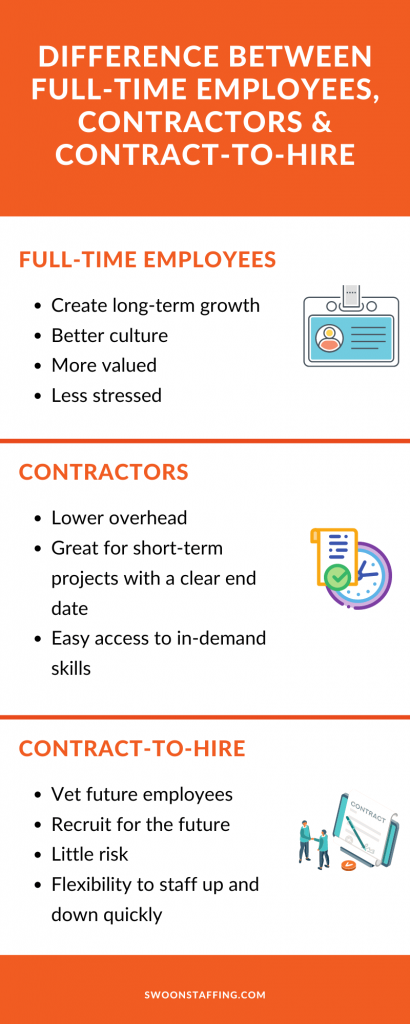
Recap of Definitions
Direct Hire Placement: A staffing agency adds permanent staff directly to another company’s payroll.
Temp Staffing: A candidate is hired as a solution for unpredictable workloads, project work, seasonal peaks and other short-term needs such as a leave of absence. They are employed by the staffing agency and all positions have an established timeframe.
Contract-to-Hire: The selected candidate begins their employment contract on the staffing agency’s payroll, not the client’s. They are placed in a short-term position for a set period, with the possibility of being hired as a full-time employee at the end of that contract.
Advantages
Direct Hire:
- The candidate is sourced as a full-time employee from day one. This allows you to avoid the annuity costs associated with contract/contract-to-hire employees and your new hires feel that they are part of the team right away.
- Direct hire roles are more attractive to passive candidates. Thus, allowing you to see a higher number of highly qualified candidates.
- This is evident because you can offer better perks and benefits packages to attract the type of prospective candidates you are looking for.
- Typically, there is stronger employee commitment. These employees often have a better sense of stability and security within the company that they are placed in.
Contract/Temp Employees:
- Saves your company time and money. These employees allow you to get the help that your company needs quickly without the cost and effort of recruiting and hiring full-time staff members.
- Offers flexibility by helping companies fill openings quickly that are caused by seasonal demand or employee absence. This way, companies can meet demands while not overstaffing or requiring current team members to take on more tasks.
- You can tap into skills that you currently don’t have inhouse. This way, you can quickly complete projects that your current team members don’t have the skills or experience.
Contract-to-Hire:
- The ability to experience a trial run. You can “try before you buy” and minimize the risk of an employee not being a fit long-term.
- There is more budget flexibility.
- These positions can give a company the time to work a new full-time employee into the budget while still getting the work done.
- Contract-to-hire employees are typically not eligible for benefits until they become a full-time employee. However, in most cases, they get the option of receiving benefits through the staffing agency they are working with.
- The employees are typically only paid on an hourly basis for the specific hours worked rather than a fixed salary.
- You can save on specialized skills that you don’t already have in-house. Contractors can help you complete projects that require skills and experience that your full-time staff doesn’t already have.
- Contract-to-hire can help you accommodate growth. We can’t always predict when growth or expansion needs to happen, and this can be extremely difficult for your full-time employees to take on additional work themselves when they have a full workload already. During these times, you can leverage contract staffing to complete the necessary extra work.
How Does Contract-to-Hire Work?
When you use a staffing agency to fill contract-to-hire positions, they will handle many of the front-end recruiting tasks, such as:
- Sourcing candidates
- Reviewing resumes
- Conducting initial screenings
Once a candidate has moved through these stages, they will be passed along to the client for final interviews. The company will then make the final decision with insights and guidance from the staffing agency if needed. Once a candidate is selected and accepts an offer, they will begin their employment contract on the staffing agency’s payroll rather than the client’s.
The duration of these contract-to-hire positions varies from one month to being indefinite. However, they will usually run from three to twelve months. In most situations, the client will have the opportunity to convert the contractor to a full-time hire in a manner that meets their needs.
Why Would a Company Dismiss the Idea of Hiring a Contractor?
When it comes to a company dismissing the idea of hiring a contractor, a few things come to mind.
- Contractors can be more expensive than hiring a full-time employee, depending on the situation.
- It’s more cost-effective to pay for a full-time employee than a contractor if you are going to keep them on for 2-3 years in some cases.
- Operating expenses (OPEX) are the cost of doing business, such as employee wages, utilities, insurance, and rent required for the day-to-day functioning of a company (including employee wages). In contrast, a capital expense (CAPEX) is an expense that a business incurs to create a benefit in the future (such as an IT project to upgrade a system that could require contractors to come in and complete that project). OPEX and CAPEX are treated quite differently for accounting and tax purposes and could be the reason for hiring one over the other.
- Companies don’t want to lose intellectual property. However, as a company hiring a contractor, you can have a written agreement executed before the commencement of the employment relationship. This agreement can assign to the company any and all intellectual property created by the employee during their employment with the company.
- Companies don’t have a history of hiring contractors and are unaware of the process – this is where we can come into play and help you understand the best path for your needs.
- Companies have budgetary challenges and might not be able to afford the contractor fees on top of the full-time employee fees if they choose to hire after the contract is up.
- Employees miss out on getting proper integration into the company culture.
- A company is challenged to bring in revenue, thus putting projects on hold that they could bring in a contract-to-hire to complete.
Why is Direct Hire Skyrocketing During COVID-19 and Not Contract-to-Hire?
At the beginning of this recession, we thought that we would see an increase in contract-to-hire over direct hire placements. When asked, Joe Matalone – EVP, had a great response to why he believes that direct hire placements are skyrocketing now.
“I think we can find our answers here in analyzing the U.S. stock market and employment data at the beginning, middle and present times of COVID-19.
Beginning of COVID-19: What we saw in the very early days of COVID was simply confusion at all levels as it came at us so quickly – which frankly jolted the global markets. Millions were furloughed during the pandemic, with a record 20.5 million U.S. jobs lost in April. However, some companies were and still are hiring thousands of new employees to keep up with shifting consumer demands and spending habits. That being said, some employers may have cut too deeply (particularly in the departments of Talent Acquisition) and have now realized that they need to hire again and hire quickly to maintain any competitive edge. Suddenly, there is a fresh wave of talent that the employers have not seen in many years due to the historical run of strong overall employment numbers.
Present Day: Fast forward to the present; it feels like the market is tightening again in specific skillsets, most notably in digital and technology, which were more resilient to the downturn. It’s almost as if we’re not in a recession any longer.
Final Thoughts: I think this will be the fastest end to a recession ever! Some areas of the market will take longer to recover, such as travel/retail/hospitality. Some employees that had been placed on leave, laid off, or maybe not treated so nicely during the last few months are looking and have options. You add in the embracement and acceleration of hiring remote workers now, and the talent pool gets very large.
During economic downturns, candidates are unwilling to leave their current “permanent” position for anything but a direct-hire position. When the country is in the middle (or hopefully tail end) of a pandemic, benefits such as health insurance are top-of-mind for everyone.”
Joe Matalone – EVP at Swoon
Conclusion
It’s important that you take a look at what is best for your company at that time. What works for one company might not necessarily work for yours. Will your company benefit more from having a direct-hire placement for a full-time employee, a temporary contractor or a contract-to-hire so that you may “try before you buy”? There is no right or wrong answer. It all just comes down to what you think will be the best, and if you have any questions along the way, we are always here to help!
Companies are still hiring but are now faced with a new challenge – onboarding new hires remotely. As employers, it’s important to set the groundwork for bonding, culture and expectations in order to be successful. Being that many of our clients are facing similar challenges, we wanted to share a few best practices that will set you new team members up for success.
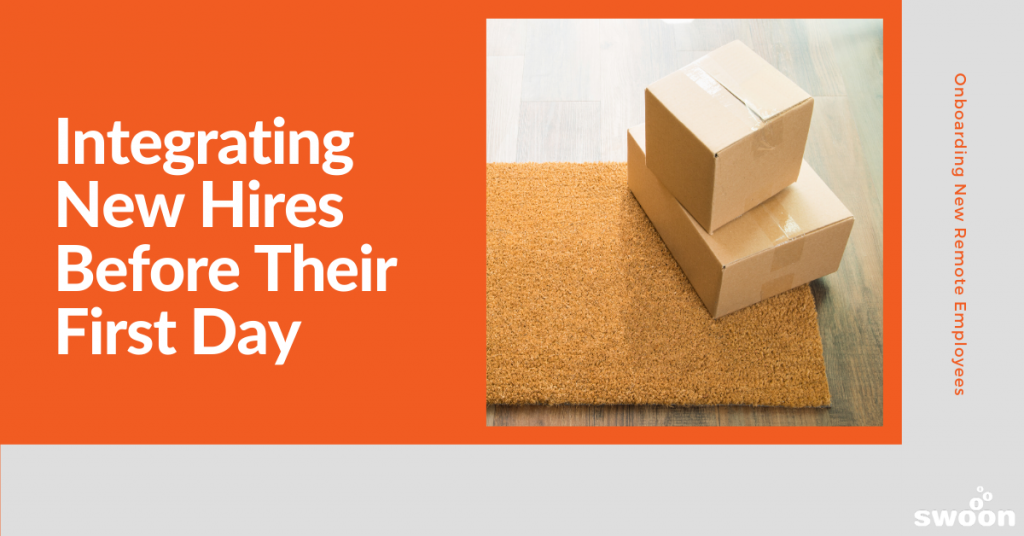
Integrating New Hires
Starting your onboarding process before their start date ensures that your new hire will have everything that they need to hit the ground running. Some suggestions on items to send before their first day include:
- Welcome email and team introduction
- HR/company documents
- All proper equipment/technology
- The information they should know before their first day
- Their onboarding schedule—this way they can be prepared for what their first week will entail
- Company swag to feel a part of the team and get excited for their new role

Tech Should Be First Priority
Let’s take a minute and put ourselves in the position of the new hire. Starting a new job can be stressful enough without adding in the issue of not knowing how the various software platforms and communication channels work. We find that sending new hires their equipment and online tutorials/manuals before their first day helps them to feel prepared and eases any unnecessary stress. You’ll want to make sure that you have a follow up IT training scheduled for the first or second day. That way, any questions that your new hires have after watching the tutorials or reading the manual can be answered right away.
Things to cover during your IT training could include:
- Company email
- Group messaging tool
- Video communication software
- File-sharing applications (Google Drive, Dropbox, Microsoft OneDrive, etc.)
- Computer and email security applications

Demonstrating Culture
We know this can be a challenging thing to do through an online platform. But, taking the time to show your company’s culture can really add value to the new hire’s first week. Through video calls, you can accurately demonstrate your company’s culture while offering a way for everyone to feel included in their first week. It also allows you to introduce them to higher-level executives, either through a video conference call or a prerecorded video. Some video topic ideas to show your company culture can include:
- Welcome video or video call from your CEO or President and other team members
- Your culture, organizational values and mission, the history of the organization, etc.
- Inspirational messages from a member of your leadership team
- Retreat, event, volunteering, etc. footage from before everyone was social distancing

Setting Expectations
When working remotely and bringing on new employees, managers should be prepared to set specific goals and expectations early on. You don’t want them to have to wait for their manager or team lead to get online to learn what their next tasks are for that day. This wastes time and may cause unnecessary stress. You’ll want to make sure that your hiring managers:
- Develop and share a task calendar with their new hires after their training and onboarding sessions are complete
- Define short-term and long-term goals
- Schedule weekly one-on-one meetings to discuss upcoming projects, progress, resolve any issues they are facing, and overall just check in with how things are going
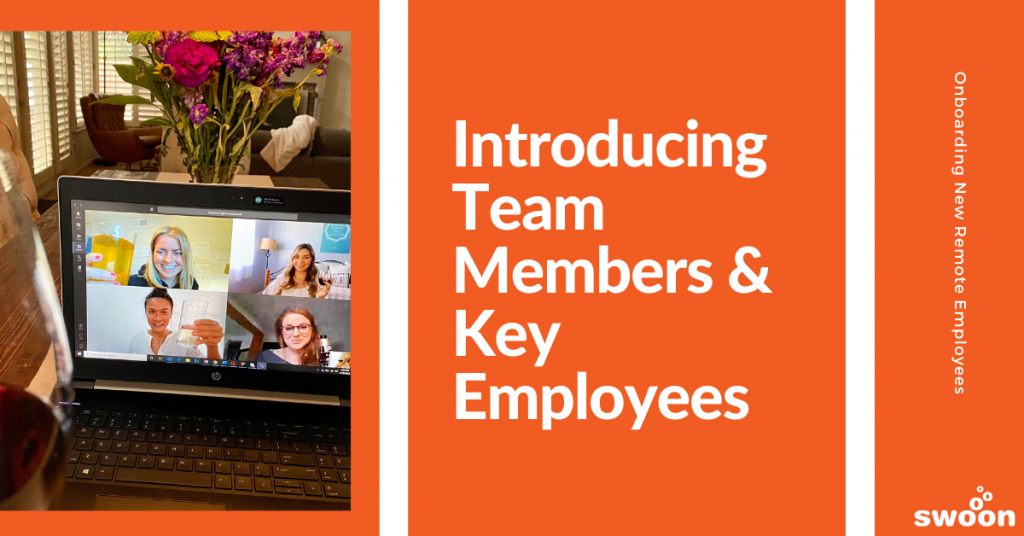
Introducing Team Members and Key Employees
We all know that starting a remote role can leave some feeling isolated and even left out from the team. They haven’t had the chance to connect with the team and doing so online can prove to be very challenging. But, building relationships is well worth the effort! Set up one-on-one meetings and/or a group call so employees can meet the people they will be working with. Not only does this open a path for communication, but it also allows them to feel included within their team. Try having the manager set up bi-weekly team meetings, virtual happy hours or an open chat channel to give everyone on their team time to talk with their new coworker.

Arrange Trainings
Now we know that this is probably self-explanatory, but make sure you set aside time for the new hires to sit down with a hiring manager or a team member to train them on their role. This can be very similar to how you train in the office; however, you will need to adapt to be virtual. Screen sharing is a great way to keep things simple. We find that this is the easiest way to adapt, and it allows the new hire to ask questions in real-time, something that might be more difficult if you were to only do a prerecorded training.

Improving Your Process
Continue to improve your onboarding process to find what bests works for your team and your culture. Ask for feedback and don’t be afraid to be creative in tackling these new challenges. We predict remote hiring will become even more common, so this is a great time to build onto an ongoing process.
Need some more help with your remote onboarding process? We would love to talk you through what has worked for us in the past and answer any questions that you have!
Grab your drink of choice, cuddle up next to your pet and get ready for your next happy hour!
Right now, since everyone is in sort of a long-distance relationship, virtual happy hours are more important than ever to keep up with social interaction, have some laughs and figure out different ways to connect with each other.
There are many ways that we’ve found to keep our employees engaged and feel involved while working remote and we want to share those with you!
Have Fun!
One way that we’ve found to keep these virtual happy hours fun and really learn more about each other is to incorporate remote team building! Not only does this allow your employees to know each other, but they are also a great stress-reliever.
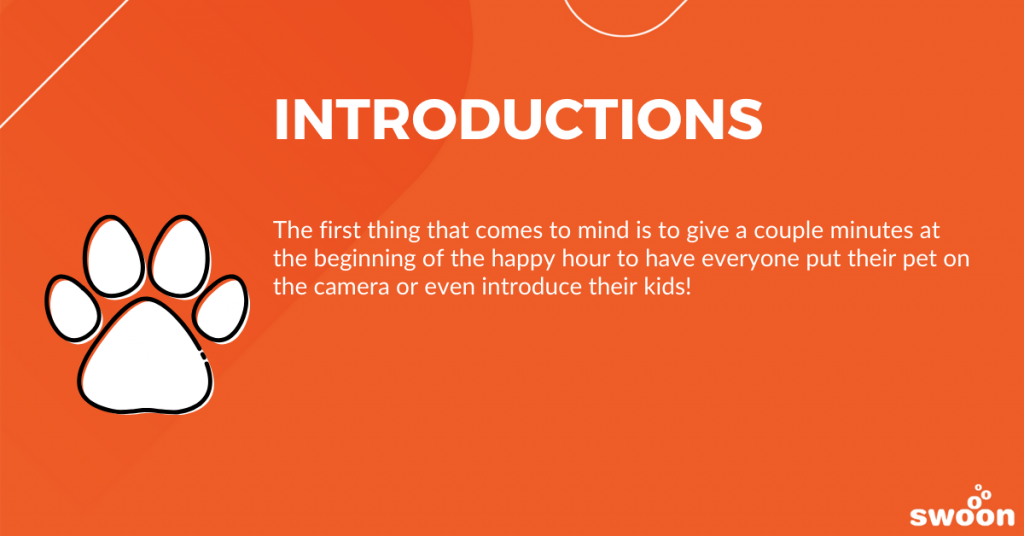
Introducing Pets/Kids!
Coworkers hear stories about everyone’s kids or pets either when they were in the office or over chat. Give them the opportunity to meet them on camera.
Play Some Icebreaker Games
Okay, we know what you’re thinking, “…but these are so cheesy!” Yes, we know they’re cheesy, but they’re also amazing at allowing your employees to talk and get to know each other better. Being remote can get extremely lonely and you want to offer time for employees to unwind. Here are some of our favorites!

1. What’s Your Favorite Thing?
This is a great game to play when you aren’t sure how people will respond to playing an icebreaker game during a happy hour.
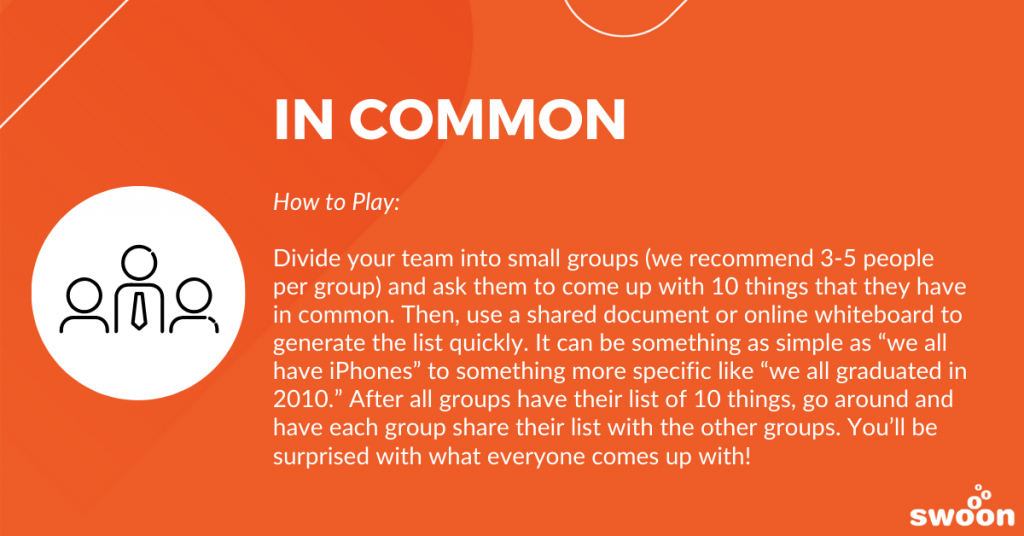
2. In Common
Is your team having trouble coming up with new ideas or communicating effectively while being remote? This could be your solution! This game allows your employees to get back on track and work as a team to achieve the end goal in a non-stressful environment!
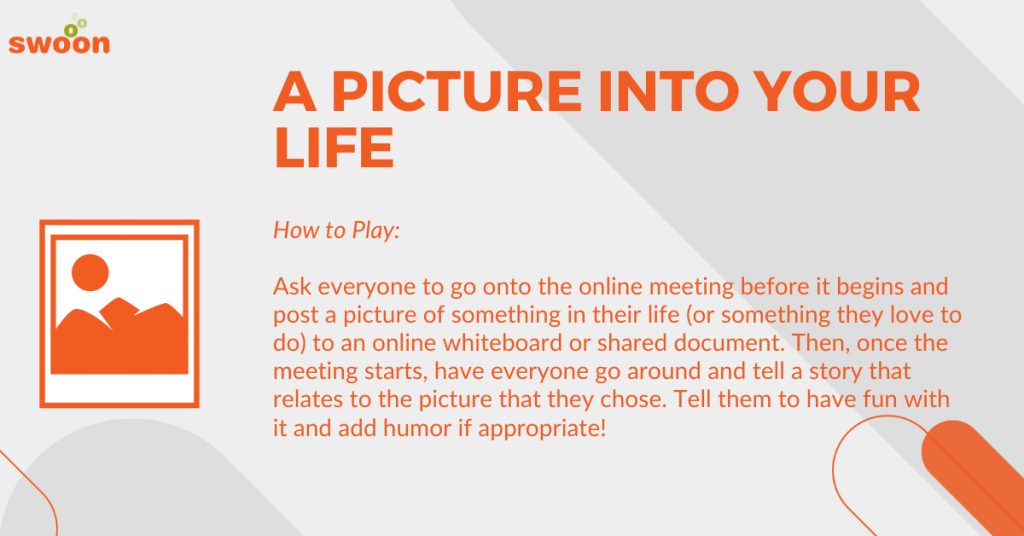
3. A Picture into Your Life
This game will allow your team to have fun and put their creativity to the test!
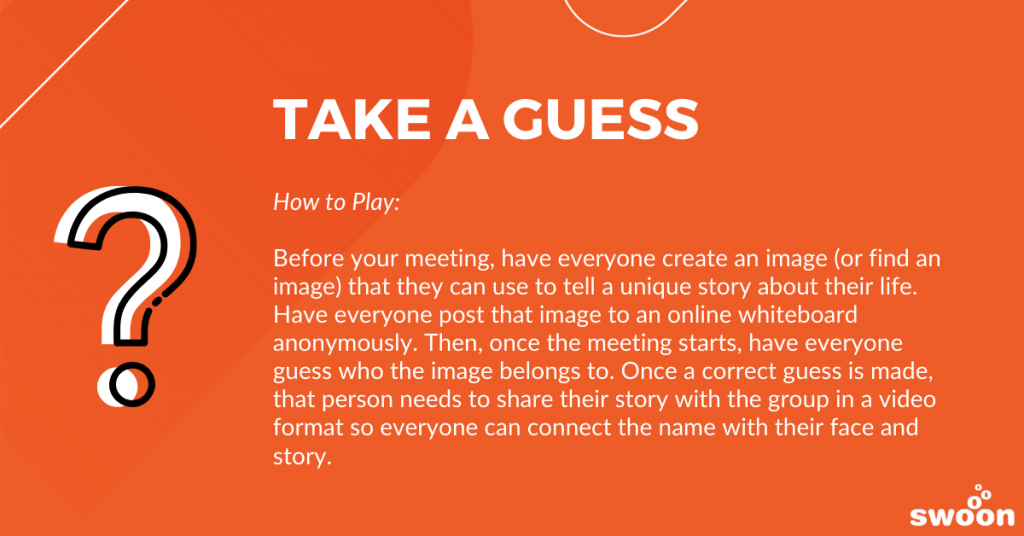
4. Take A Guess
Here is another game that allows your employees to utilize their creativity skills and learn about their coworkers in a fun way!
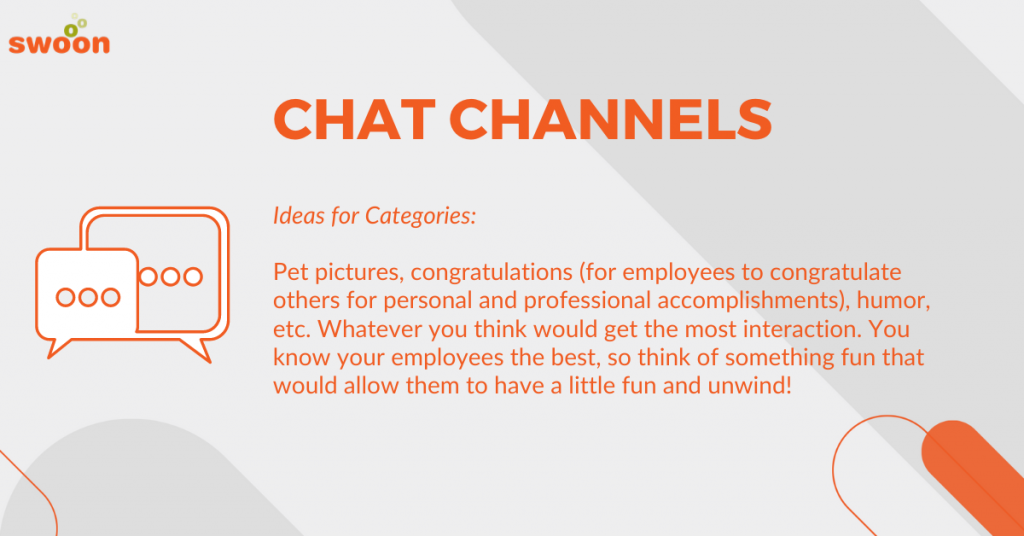
5. Chat Channels
Create fun, dedicated chat channels and announce them during your virtual happy hour. Do you know that your employees won’t respond well to a team building exercise? This could be the way that you get your employees to connect in a remote environment!

Keep It Simple!
You don’t need to always do something outside the box. Sometimes, the best way to get your employees to feel included is to just set up a time and space for them to talk and see one another. Having them add in their drink of choice allows the environment to feel a little more comfortable and laid back.
Need Help?
We would love to help you and your team navigate this new work from home environment! No matter if that’s through finding the best virtual happy hour solution or just the best work from home solution for you and your team. We’ve been doing this for a little over a year, so we would love to provide you with our insight! Feel free to send us a message!

